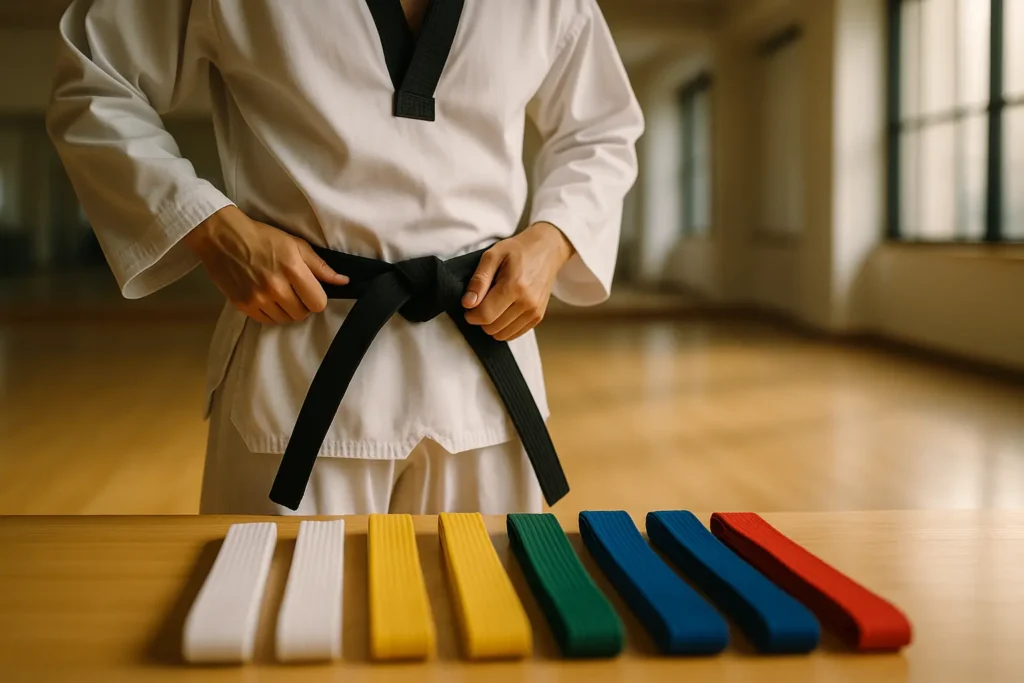Is the taekwondo belt just an accessory or a hidden reflection of your progress? Discover how this strip of fabric embodies an age-old colour code, blending symbolism with technical requirements. From the innocence of the white belt to the prestige of the black belt, this guide explores Keup grades, the Dan and Poom systems, and tips for tying and choosing your belt. Learn the meaning of the colours: yellow for foundations, blue for technical expansion, red for mastering power. A key read to understand why it is far more than a simple tie around your dobok.
The taekwondo belt: much more than a simple accessory
The taekwondo belt, called Ti in Korean, symbolises progression, discipline and the philosophy of this martial art. One of the most practised combat sports in France, taekwondo structures learning around Keup grades for coloured belts and Dan grades for black belts.
Each colour marks a symbolic stage. White (10th Keup) represents the beginner’s innocence, yellow (9th Keup) symbolises foundations, green (7th Keup) growth, blue (6th Keup) elevation, and red (3rd Keup) control of powerful techniques. Black (1st Dan and above) signifies mastery, but also the beginning of a deeper spiritual journey.
Progress varies by age and school. Children under 12 progress through 15 Keup with intermediate colours such as orange, purple and brown, while adults follow 10 Keup. Dan ranks span nine levels, from 1st to 9th, with titles such as Boosabum for 1st to 3rd Dan or Saseong for 9th Dan. The black belt, often viewed as an end point, is in reality the start of a quest for perfection. Belts are traditionally not washed and bear the marks of the practitioner’s efforts.
Beyond black, Dan grades remind us that taekwondo is a lifelong discipline. Higher titles at 7th Dan and above honour masters who have devoted decades to the art. Each colour reflects a unique path, balancing tradition, personal challenge and self-transcendence.
The taekwondo grading system: the order of coloured belts (Keup)
| Grade (Keup) | Belt colour | Symbolic meaning and associated skills |
| 10th Keup | White | Purity, innocence, the start of the journey. The practitioner is a blank page, ready to learn. |
| 8th Keup | Yellow | Earth. Foundations are laid and first techniques are planted. |
| 6th Keup | Green | Growth of the plant. Techniques start to develop and strengthen. |
| 4th Keup | Blue | Sky. The practitioner rises and their technical horizon widens. |
| 2nd Keup | Red | Danger. The practitioner has powerful techniques and must learn to control them. It is also a warning to opponents. |
From white belt to red belt: a learning path
White belt (10th Keup) symbolises a clear, open mind. Fundamental basics such as stance, strikes and respect for martial principles are introduced.
Yellow belt (8th Keup) marks acquisition of the basics. The practitioner learns balance, movement and first formal patterns, like a seed taking root.
Green belt (6th Keup) shows technical improvement and fluidity of movement. The practitioner integrates taekwondo philosophy, combining physical and mental discipline.
Blue belt (4th Keup) symbolises technical elevation and the acquisition of automatisms. Techniques become precise and reveal the art’s complexity.
Red belt (2nd Keup) signifies the control required when handling powerful techniques. It embodies technical maturity and mastery of one’s strength.
Intermediate grades and variations by federation
Two-tone belts or coloured tabs indicate intermediate steps for gradual progression, especially for younger practitioners.
Systems vary by federation. Bodies such as the FFTDA with 15 Keup or the ITF with coloured piping illustrate these differences. For example, a yellow belt with orange piping does not exist in every school.
The black belt marks a new beginning. Beyond that, Dan grades run up to 9 levels, each Dan symbolising greater mastery and a teaching role.
Refer to your dojang’s system. Criteria may differ between schools in line with local traditions.
Beyond colours: the black belt (Dan) and the Poom belt
The black belt in taekwondo marks a turning point. It is the start of a demanding path toward technical and mental mastery. The Poom belt, reserved for under 16s, validates an advanced level for young practitioners while preparing their transition to higher grades.
The prestigious black belt and Dan degrees
1st Dan is obtained at 14 or 15 years old depending on the federation. Dan ranks rise to 9th or 10th Dan, with increasing age requirements from 4th Dan, often 21 years minimum. This structure aligns progression with the practitioner’s maturity.
Black belts carry responsibility. They pass on skills, uphold values and represent the art. They must master techniques as well as the philosophy and history of taekwondo.
The special case of the Poom belt for young practitioners
The Poom belt, red and black, is for those under 16. It recognises early mastery with strict conditions for conversion to Dan. The practitioner must reach 15 and show regular training. If training was interrupted, six months of practice are required before conversion.
- Black Belt (Dan): for adults, validates confirmed expertise.
- Poom Belt: equivalent grade for juniors, highlighting an advanced level.
- Conversion to Dan: 1st Poom becomes 1st Dan at 15 after validation of practice.
Poom holders must follow their federation’s rules for a successful transition. The system balances rigour and accessibility, adapting progression to age and commitment.
Practical guide: how to choose and tie your taekwondo belt
Choosing the right belt size
Belt size affects comfort and appearance. A poorly fitted belt can hinder movement or come undone during training. As a rule of thumb, the belt should wrap twice around the waist and hang evenly, ideally down to mid-thigh when tied.
Belts are usually robust cotton, sometimes with topstitching for durability. Lengths vary in 10 to 20 cm increments such as 220 cm or 240 cm. To determine your size, use this formula: length = waist measurement × 2 + 110 to 120 cm. For example, an 80 cm waist needs a 280 cm belt.
Brand guides such as Meiji or Shureido provide standard sizes: T3 at 240 cm for children, T4 to T5 at 260 to 280 cm for teens, and T6 to T8 at 300 to 340 cm for adults. If in doubt, measure your waist at the navel and consult an instructor or the manufacturer’s guide.
The art of tying your belt: steps and tips
Tying the belt correctly is fundamental. It symbolises respect for tradition and personal discipline. Steps for a neat knot:
- Fold the belt in half to find the exact midpoint.
- Place the midpoint on your abdomen just below the navel.
- Wrap both ends around the waist, crossing at the back, then bring them to the front without twisting.
- Cross the left end over the right.
- Pass the left end under both layers in front and pull up.
- Adjust so the ends are equal.
- Make a simple knot by passing the upper end under the loop.
- Tighten horizontally for a flat knot with symmetrical ends.
Each end should be 20 to 30 cm once tied. A loose knot may come undone, while an overly tight knot lacks neatness. In grading or competition, a poorly adjusted belt can be seen as unprofessional. Practise in front of a mirror to master this essential skill.
The belt as a reflection of the taekwondo practitioner’s journey
The taekwondo belt is not just an accessory. It embodies the practitioner’s evolution from hesitant beginnings to demanding mastery. Each colour marks growth both physical and mental, and above all inner transformation.
White symbolises the novice’s innocence, yellow lays foundations, green illustrates progression, blue evokes widening skills and red reminds us of necessary vigilance. The black belt, often perceived as an end point, is in fact a new start toward higher grades reserved for dedicated experts.
- Perseverance: each grade is earned through determination to overcome challenges.
- Respect: fundamental toward instructors, partners and traditions.
- Humility: recognising that learning never ends, even for experts.
Behind the system lies a demanding philosophy. Criteria may vary between schools, but the essence is the same. Cultivate courtesy, integrity and indomitable spirit. A first-degree black belt is not the end of learning but a solid foundation.
For steady progress, proper kit matters. Staying hydrated with a suitable sports bottle preserves energy, a key to climbing the ranks.
The taekwondo belt embodies the practitioner’s path. Each colour testifies to commitment and personal growth. More than a symbol, it represents perseverance, respect and humility. For fulfilling practice, remember to hydrate with an appropriate bottle.






